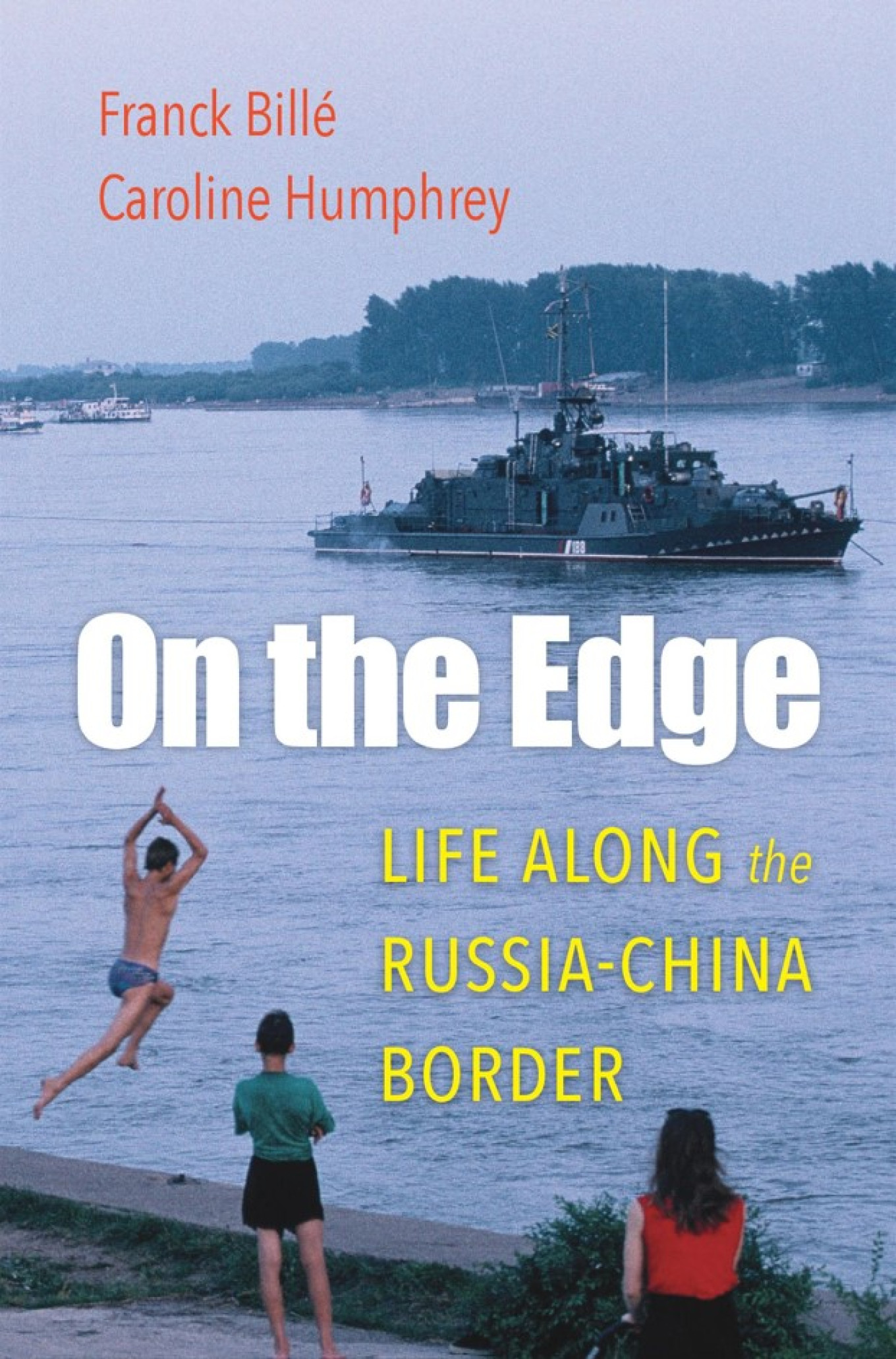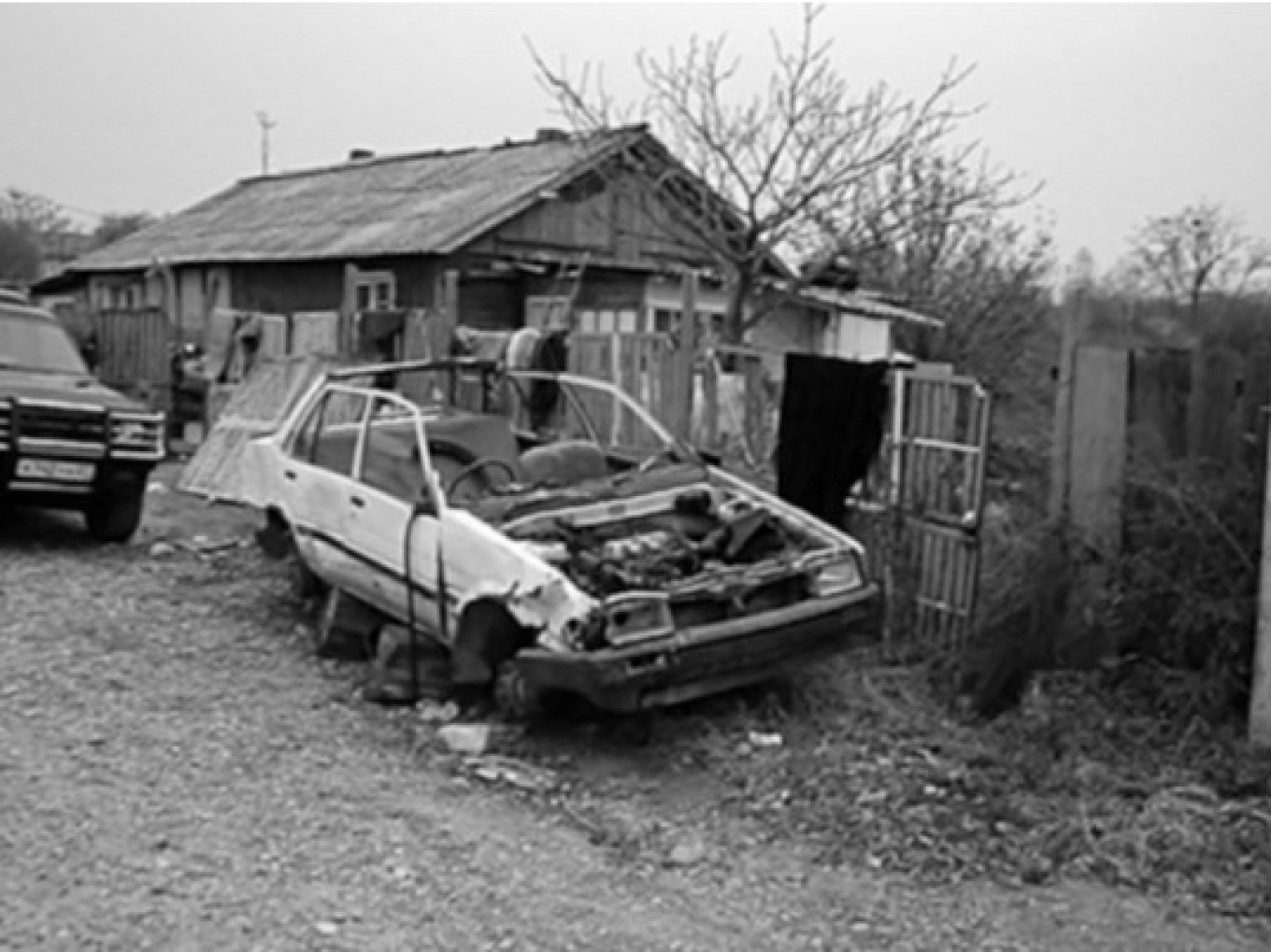Two "super powers": One in economic decline and seeking to regain its imperial status by brutally attacking a democratic neighbor, the other in seemingly unstoppable economic ascendence, inexorably extending its "Belt and Road Initiative," and, with it, its global influence.

These are the Russia and China of international headlines. Both anti-Western, both powers (and problems) to be reckoned with. "On the Edge: Life Along the Russia-China Border" by Franck Billé and Caroline Humphrey drills down beneath these surface-level representations, offering the first comprehensive analysis of how the lived experiences of the inhabitants of these peripheries intersect with the grand national and geopolitical visions emanating from the political centers of Moscow and Beijing. Billé and Humphrey set the stage for the complex drama that unfolds daily in this liminal space: "Unlike the geographical setting of most historical empires and current world powers [...] here there is no buffer zone, no intervening territory of client or hybrid states, and no ocean to soften the sovereign conjunction of Russia and China,” they write.
The stage of “On the Edge” is the 2,600 mile-long border and its cast of characters are not only the inhabitants but also the ever-changing cities they inhabit — most notably Blagoveshchensk and Heihe. In seven chapters and 269 pages, Billé and Humphrey take the pulse of this complex region through analyses of the infrastructure, economic development, identities, and world views on both sides of the border which “has become a thin line of direct engagement, extraordinary contrast, and frequent tension.”
“On the Edge” speaks to the emotionally and politically charged nature of borders that we see, for example, between the United States and Mexico, and the European Union and North Africa. But, they write, "there was nothing inevitable about the borders established in the seventeenth and eighteenth centuries, for there were no consolidated culturally different populations to be separated [it was not until the twentieth century that the borderlands were populated en masse by Russians and Chinese."
Even now, when the border is supposedly accepted and respected by both sides, the imaginative geography of the populations continue to spill beyond it, with the marshy island between the two countries offering a prime example. While the territory is split between Russia and China, each still uses its own names for the whole: the Russians call the main island Bolshoi Ussuriisky and the adjoining island Tabarov, while the Chinese call the whole archipelago Heixiazi (Black Blind). "This naming habit," write Billé and Humphrey, reflects inherited 'law of nature' imaginaries and the fact that both Russia and China historically claimed the whole area."
The first comprehensive analysis of how the lived experiences of the inhabitants of these peripheries intersect with the grand national and geopolitical visions emanating from the political centers of Moscow and Beijing.
Symbolic of the arbitrary nature of borders is the observation of Dasha, a student at the Blagoveshchensk Pedagogical Institute: “When visitors come to our city, they like to look at Heihe’s lights from the Russian embankment [...] But because the two cities are so close, occasionally a visitor will not realize they are looking at China. They look at Heihe and ask how they can reach the city center.”
As Russia's starkly colonial act of war against Ukraine rages on into its fifth month, Billé and Humphrey's study of the border's indigenous people — among them, Buryats, Evenks, Nanai, and Hezhe — and their relations with settlers from the imperial metropoles of Moscow and Beijing feels particularly resonant. The very idea of indigeneity, the authors write, is "problematic and even dangerous" because it "rests on narratives of autochthonous or prior settlement [...] and undermines state claims based on conquest, imperial purview, international treaties, [and] superior civilization."
Yet identities, like borders, are not naturally occurring phenomena. The names ascribed to these groups are "essentially the outcome of successive governments' attempts to create order among the mobile and amorphous groupings that historically split up or consolidated, and sometimes changed their ways of life and ethnic allegiances.” As ethnic minorities in Russia are turned into cannon fodder by the Kremlin and those in China face, at best, objectification and, at worst — in the harrowing case of the Uighurs — extermination, Billé and Humphrey's examination of how State policies towards indigenous peoples play out in the imaginaries and everyday interactions on the border gains particular urgency.

Billé and Humphrey avoid romanticizing the border and the exchanges that take place along it. Instead, they give due attention to its less savory elements such as the derogatory stereotypes that Russians hold of Chinese people — they view their neighbors as “less developed and less cultured” — and the violence of the “nephrite war” in which rival gangs competed over control of the deposits of the stones so highly valued by the Chinese market.
As is fitting for a book about the porousness of borders, “On the Edge” blends the academic and theoretical with the personal stories and evocative descriptions of place. For an academic audience, the book offers compelling case studies in historical memory, imagined communities, and imperial projects. For the general reader, “On the Edge” fleshes out reductive media representations, illustrating how the ostensible political friendship between Moscow and Beijing is manifested, rejected, and contested in the everyday lives of ordinary people. On the Russia-China border, the personal is political and the political is personal.

Excerpt from "On the Edge: Life Along the Russia-China Border"
A People Split Apart: Nanai and Hezhe
In both Russia and China a few settlements have been given special status as “ethnic villages” and set up to support indigenous culture and attract visitors. visitors. But the two countries do this very differently. First, we should note that history has scattered the Nanai and Hezhe and that they do not all inhabit ethnic villages, nor is the population of these places entirely made up only of the designated ethnicity. This is particularly the case in China, where villages were integrated into huge multiethnic communes in the Mao era and are now incorporated in wide “townships” in which Han people and the Chinese language dominate almost everywhere. Throughout the frontier zone it is rare to find a monoethnic settlement. Indigenous people tend to be multilingual.
In Shenehen near Manzhouli we met, for example, a Daur driver who took for granted his own fluency in Chinese but also spoke Buryat, Evenk, Manchu, and Mongolian along with his native Daur. Furthermore, even in the ethnic villages, the old life of hunting and fishing in the wild is long gone. Now both activities are strictly limited and only legal at certain times for people with licenses. The restrictions are similar in both countries, but otherwise there are many divergences. In the Hezhe ethnic village Zhuajizhen (抓吉镇) on the Ussuri River 7 miles south of Fuyuan, residents’ prospects have transformed since it was included in the tourism complex of Heixiazi Island (see Chapter 2). The villagers had lived from modest fishing, farming soybeans, rice, corn, potatoes, and raising a few sheep and goats. Now the mudbrick-thatched roof or concrete cottages have been replaced by showpiece varnished wooden houses, white stucco villas, and four-story apartment blocks. The Square of the One Hundred Cooking Pots, a paved area in the shape of a giant fish, was constructed for the tourists. The fish’s eye is represented by a giant decorated cauldron swinging from tall poles, and the outer contour of the fish consists of a curved awning that shades the 100 brick cooking stoves—designed, it seems, for mass feasting on fish. The center of the plaza is adorned with bronze-painted sculptures depicting Hezhe people engaging in their traditions: fishing, wrestling, sitting round a campfire, and so forth. This fanciful construction was much damaged in the 2013 floods, and a Russian tourist visiting it a year later found it deserted.
The plaza has since been repaired, and when the governor of Fuyuan arrived on a visit, he gave an unclear speech that nevertheless revealed the true purpose of the village’s transformation: “To preserve the ethnic customs of the village for future projects for greening and improvement of the territory and infrastructure. Officials should support village rebuilding and the developments on Heixiazi Island; they should integrate tourism with rural and urban policies and play their part in the district [Fuyuan] and province [Heilongjiang] in order to achieve urbanization.” A Russian blog describing the transformation pictured a tipsily grinning Hezhe villager, happy with his lot; a sour Russian comment was that the splendid new housing in Zhuajizhen village was just pokazukha (put on for show) to impress the Nanais on the other side of the border.
Indeed, this relentless improvement contrasts with the Nanai settlement of Sikachi-Alyan, likewise designated a “national village” and tourist site, located on the Amur not far from Khabarovsk. Urbanization is not the goal here. Instead, Sikachi-Alyan is advertised as a place to see ancient relics: engravings of whorls, fish, animals, and human-like faces on the black basalt boulders on the river shore. Unlike the tourist attractions in the Chinese village, these are genuine, and Russia is applying to UNESCO to accord them international recognition. The petroglyphs are many thousands of years old, made by unknown predecessors, and the Nanai revere them as the placings for spirits. The village, which contains people of several ethnicities as well as Nanai, is half deserted. Its ethnographic focus is a small, informative museum located in the basement of the only new construction, the Culture Center—a multifunctional building also containing the administration, the club, and the kindergarten. In the museum the brilliant intricate embroideries of the old Manchu-esque ceremonial attire jostle strangely with rough-hewn utensils and wooden images of spirits. Nearby, empty reconstructed traditional houses and fish-drying sheds form an “ethno-tourist complex.” Otherwise, the village has been left in all its post-Soviet authenticity—battered wooden houses, rutted roads, rusting car wrecks, and TV antennas (Figure 4.1).
A Russian adventure tourist, videoed picking his way among the boulders excitedly discovering engravings here and there, commented that no doubt in China such a place would be full of counterfeits, but, he said with a laugh, “in Russia we haven’t got anyone to make fakes.” In this place, he said, looking around, people live extremely poorly. The villagers too complain that there is no work, and fishing is strictly limited. Much of their income comes from selling souvenirs—embroidered slippers, dolls, mats, and, at the pricey end, shaman’s costumes and fish-skin coats—in the Culture Center; occasionally children put on a dance or elders perform ceremonies for tourists for a fee.
The petroglyphs are left unguarded. When the villagers were informed that the engravings were valuable “cultural heritage,” they set someone to guard the site and charged 100 rubles per visitor; instantly, though, they were forbidden to do this by the district administration on the grounds that permission had not been given and the fee not agreed with the Ministry of Economic Development. Each season, the boulders disappear from sight when the murky Amur is at high water. When they reappear, the most visible engravings are the bright new ones chipped by tourists (“Oleg and Tanya were here”).

The “ethnic villages” in each country are indicative of the general situation of the two groups: the Hezhe in China are engulfed in development, while the Nanai in Russia are languishing for the lack of it. The Nanai villages of the lower Amur are depopulated, depopulated, the fishing stocks are depleted, the waters are polluted, and the people are racked by the social ills of unemployment, alcoholism, drug addiction, and premature mortality. In sharp contrast, the Hezhe have become a tourist attraction, but they are also part of a diversified regional economy, including agriculture and small business along with fishing. It is relevant to such comparisons that there are only 4,600 Hezhe (as of 2018) and they are scattered in small groups across Manchuria, whereas there are 12,000 Nanai (as of 2010), most of whom live in villages strung along the lower Amur. But still, why do the two populations hardly recognize each other?
Borderland people are not necessarily enthusiastic about establishing relations across the frontier just because they have been told that people of their own ethnic group are living on the other side. And if they do travel across for business, belonging to the same ethnic group does not in itself ensure mutual trust. For such relations to thrive there have to be other powerful factors at play. We have already mentioned the role of population size and Russia’s KMNS policy in identity politics. The “small-numbered” groups define themselves exclusively, assert their uniqueness, and almost perforce emphasize the “traditional” aspects of their culture, whereas for the larger peoples it is advantageous in the politics of their titular republics to be more numerous and powerful. They cannot forget Moscow’s history of splitting them apart, and therefore they include in their self-definition all related groups, even those living in other regions. However, sheer size and the corresponding stance in the regional political situation is not a sufficient explanation. The Khamnigan, one of the smaller, more obscure and downtrodden of borderland groups, provide a counterexample. Despite lack of numbers and with no recognized administrative unit to call their own in China, Russia, or Mongolia, Khamnigan enthusiasts are currently embarking on the expansive version of identity politics. To explain this, we suggest that a second crucial factor is the nature of the historical dispositions present in some groups but not others.
Excerpted from “On the Edge: Life Along the Russia-China Border” by Franck Bilé and Caroline Humphrey, published by Harvard University Press. Copyright © 2021 by the President and Fellows of Harvard College. Used by permission. All rights reserved. Footnotes have been removed to ease reading. For more information about the authors and this book, see their publisher’s site here.
“On the Edge: Life Along the Russia-China Border” has been shortlisted for the 2022 Pushkin House Book Prize.
A Message from The Moscow Times:
Dear readers,
We are facing unprecedented challenges. Russia's Prosecutor General's Office has designated The Moscow Times as an "undesirable" organization, criminalizing our work and putting our staff at risk of prosecution. This follows our earlier unjust labeling as a "foreign agent."
These actions are direct attempts to silence independent journalism in Russia. The authorities claim our work "discredits the decisions of the Russian leadership." We see things differently: we strive to provide accurate, unbiased reporting on Russia.
We, the journalists of The Moscow Times, refuse to be silenced. But to continue our work, we need your help.
Your support, no matter how small, makes a world of difference. If you can, please support us monthly starting from just $2. It's quick to set up, and every contribution makes a significant impact.
By supporting The Moscow Times, you're defending open, independent journalism in the face of repression. Thank you for standing with us.
Remind me later.







